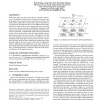1190 search results - page 174 / 238 » Network Storage Management in Data Grid Environment |
MOBIHOC
2009
ACM
15 years 10 months ago
2009
ACM
Most future large-scale sensor networks are expected to follow a two-tier architecture which consists of resource-rich master nodes at the upper tier and resource-poor sensor node...
HPDC
2010
IEEE
14 years 11 months ago
2010
IEEE
Scientists working in eScience environments often use workflows to carry out their computations. Since the workflows evolve as the research itself evolves, these workflows can be ...
GEOS
2007
Springer
15 years 4 months ago
2007
Springer
Spatio-temporal network is defined by a set of nodes, and a set of edges, where the properties of nodes and edges may vary over time. Such networks are encountered in a variety of...
ECOI
2010
14 years 10 months ago
2010
Advances in technology have enabled new approaches for sensing the environment and collecting data about the world. Once collected, sensor readings can be assembled into data stre...
GEOS
2007
Springer
15 years 4 months ago
2007
Springer
Abstract. A Wide-Area Sensor Network (WASN) is a collection of heterogeneous sensor networks and data repositories spread over a wide geographic area. The diversity of sensor types...

